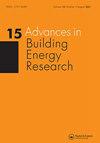Energy efficiency in hospitals: comparative analysis of different HVAC configurations
IF 2.5
Q2 CONSTRUCTION & BUILDING TECHNOLOGY
引用次数: 0
Abstract
ABSTRACTThe characteristics of health facilities e.g. the need to operate 24 h a day, strict cleaning procedures and indoor environmental parameters made these building-type energy-intensive. The huge potential that can be exploited in terms of energy savings is evident, mainly regarding the HVAC system refurbishment. From literature emerges that there are poor systematic analyses concerning all the possible HVAC retrofit scenarios, considering solutions currently on the market or renewable sources. To fill the research gap pointed out, the present paper proposes a rigorous analysis of the possible generation subsystems available on the market that can be implemented in an HVAC retrofit for a hospital. A real case study of 88,000 m3, represented by a hospital in southern Italy, has been used. Different technologies, such as the photovoltaic system, electric heat pump, absorption heat pump driven by solar energy, cogeneration are analysed from the energy and environmental point of view, with the introduction of the Imported Energy Level Index (IELI). The best retrofit measures is the installation of an absorption heat pump driven by solar thermal collectors and cogeneration, with a primary energy saving of 20%. Considering the installation of a heat recovery unit, the saving is up to 43%.KEYWORDS: Energy savingHVAC hospital building refurbishmentcarbon dioxide emission reductionrenewable sourcesImported Energy Level Index NomenclatureCO2=Carbon dioxide emission [kgCO2/y]E=Energy [GWh/y]IELI=Imported Energy Level Index [%]PES=Primary Energy Saving [%] Greek symbolsα=Emission factor for electricity generation [gCO2/kWhel]β=Emission factors for natural gas [kgCO2/kWhEp]η=Efficiency [-], [%]Δ=Percent variation with respect to base case [%] SuperscriptAHP=Absorption Heat PumpAHU=Air Handling UnitB=BoilerBMS=Building Management SystemBS=Base CaseCHP=Combined Heat and PowerDHW=Domestic Hot WaterEHP=Electric Heat PumpE-L=Electric LoadsFC=Fan-coilfg=fed into the gridHWST=Hot Water Storage TankISPRA=Istituto Superiore per la Protezione e la Ricerca AmbientalePAC=Proposed Alternative CasePP=Power PlantPV=Photovoltaic systemR=RadiatorsSTC=Solar Thermal Collectorsuos=Used on-site Subscriptco=Coolingel=Electricp=Primary energyth=Thermal AcronymsAHP=Absorption Heat PumpAHU=Air Handling UnitB=BoilerBS=Base CaseCHP=Combined Heat and PowerDHW=Domestic Hot WaterEHP=Electric Heat PumpFC=Fan-coilHWST=Hot Water Storage TankPP=Power PlantPV=Photovoltaic systemR=RadiatorsSTC=Solar Thermal CollectorsVFD=Variable Frequency DriveVP=Variable PitchDisclosure statementNo potential conflict of interest was reported by the author(s).医院的能源效率:不同HVAC配置的比较分析
摘要卫生设施的特点,如需要24小时运行,严格的清洁程序和室内环境参数,使这些建筑类型的能源密集型。在节能方面可以开发的巨大潜力是显而易见的,主要是在暖通空调系统翻新方面。从文献中可以看出,考虑到目前市场上的解决方案或可再生能源,对所有可能的暖通空调改造方案的系统分析很差。为了填补所指出的研究空白,本文建议对市场上可用于医院暖通空调改造的可能的发电子系统进行严格分析。以意大利南部一家医院为代表的88,000立方米的真实案例研究已经被使用。引入进口能源水平指数(IELI),从能源和环境的角度分析了不同的技术,如光伏系统、电热泵、太阳能驱动的吸收式热泵、热电联产。最好的改造措施是安装由太阳能集热器和热电联产驱动的吸收式热泵,一次节能20%。考虑到安装热回收装置,节省高达43%。关键词:节能hvac医院建筑改造二氧化碳减排可再生能源进口能源水平指数命名法reco2 =二氧化碳排放量[kgCO2/y]E=能源[GWh/y]IELI=进口能源水平指数[%]PES=初级节能[%]希腊符号α=发电排放系数[gCO2/kWhel]β=天然气排放系数[kgCO2/kWhEp]η=效率[-],[%]Δ=相对于基本情况的变化百分比[%]SuperscriptAHP=吸收式热泵pahu =空气处理机组b =锅炉erbms =建筑管理系统bs =基本情况echp =热电联产dhw =生活热水ehp =电热泵- l =电负荷sfc =风机盘管=馈入电网dhwst =热水储存罐pra =高等研究所(Istituto Superiore per la Protezione e la Ricerca AmbientalePAC=建议替代方案CasePP=发电厂pv =光伏系统r =散热器stc =太阳能集热器suos=现场使用Subscriptco=Coolingel=Electricp=Primary energth =Thermal首字缩写sahp =吸收式热泵pahu =空气处理机组b =锅炉bs =基础箱echp =热电联产dhw =家用热水ehp =电热泵fc =风机盘管hwst =热储水箱kpp =发电厂pv =光伏系统r =散热器stc =太阳能集热器svfd =变频驱动evp =变节差披露声明作者未报告潜在的利益冲突。
本文章由计算机程序翻译,如有差异,请以英文原文为准。
求助全文
约1分钟内获得全文
求助全文
来源期刊

Advances in Building Energy Research
CONSTRUCTION & BUILDING TECHNOLOGY-
CiteScore
4.80
自引率
5.00%
发文量
11
 求助内容:
求助内容: 应助结果提醒方式:
应助结果提醒方式:


